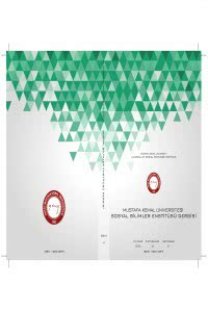İki Aşamalı Genetik Kavramlar Tanı Testi Geliştirme Ve Geçerlik Çalışması/Developing And Validating A Two Tier Mendel Genetics Diagnostic Test
İki aşamalı çoktan seçmeli test, genetik kavram testi
___
Ausubel, D.P. (1968). The psychology of meaningful verbal learning. NY: Grune and Stratton.Anderson, D.L., Fisher, K.M., & Norman, G.J. (2002). “Development and evaluation of the conceptual inventory of natural selection”. Journal of research in science teaching. Cilt: 39, Sayı: 10. (952-978).
Banet, E., & Ayuso, E. (2000). “Teaching genetics at secondary school: A strategy for teaching about the location of inheritance information”. Science Education. Cilt: 84, Sayı: 1. (313-351).
Bernhisel, S. M. (1999). Measuring preservice and inservice biology teachers' understanding of selected biological concepts. Unpublished Dissertation.Utah: Utah State University.
Brainsford, J.D., Brown, A.L. & Cocking, R.R. (2000). How people learn: Brain, mind, experience, and school. Washington, DC: The National Academy Press.
Briggs, D.C., Alonzo, A.C., Schwab, C., & Wilson, M. (2006). Diagnostic assessment with ordered multiple-choice items. Educational Assessment. Cilt: 11 Sayı: 1. (33-63).
Chen, C.C., Lin, H.S., & Lin, M.L. (2002). “Developing a two-tier diagnostic instrument to assess high school students' understanding-the formation of images by a plane mirror”. Proceedings of the National Science Council, 12(3), 106-121.
Griffard, P. B. (2001). “The two-tier instrument on photosynthesis: What does it diagnose?” International Journal Science Education. Cilt: 23, Sayı: 10. (1039-1052).
Suen, H.K. (1990). Principles of test theories. L. Erlbaum Associates, Hillsdale, NJ.
Jang, N. H. (2003). Developing and validating a chemical bonding instrument for korean high school students. Unpublished Dissertation. Missouri: The Faculty Graduate School University.
Johnson, S.K., & Stewart, J. (2002). “Revising and assessing explanatory models in a high school genetics class: A comparison of unsuccessful and successful performence.” Science Education. Cilt: 86, Sayı: 4. (462-480).
Karataş, F. Ö., Köse, S., ve Coştu, B. (2003). “Öğrenci yanılgılarını ve anlama düzeylerini belirlemede kullanılan iki aşamalı testler.” Pamukkale Üniversitesi Eğitim Fakültesi Dergisi. Cilt: 13, Sayı: 1. (54-69).
Odom, A.L., & Barrow, L.H. (1995). “Development and application of a two-tier diagnositc test measuring college biology students' understanding of diffusion and osmosis after a course of instruction”. Journal of Research in Science Teaching. Cilt: 32, Sayı: 1. (45-61).
Pfundt, H., & Duit, R. (2009). “Bibliography: Students' and teachers' conceptions and science education”. Kiel: IPN. http://www.ipn.uni-kiel.de/aktuell/stcse/stcse.html
Robinson, W., Lewis, J., & Leach, J. (2000). “Young people's understanding of the nature of genetic information in cells of an organism”. Journal of Biological Education. Cilt: 35, Sayı: 1. (29-36).
Smith, M.K., Wood, W. B., & Knight, J.K. (2008). “The genetics concept assessment: A new concept inventory for gauging student enderstanding of genetics”. Life Sciences Education. Sayı: 7. (277-282).
Tatar, N. ve Cansüngü Koray, Ö. (2005). “İlköğretim Sekizinci Sınıf Öğrencilerinin 'Genetik' Ünitesi Hakkındaki Kavram Yanılgılarının Belirlenmesi”. Kastamonu Eğitim Dergisi. Cilt: 13, Sayı: 2. (415-426).
Temelli, A. (2006). “Lise Öğrencilerinin Genetikle İlgili Konulardaki Kavram Yanılgılarının Saptanması”. Gazi Üniversitesi Kastamonu Eğitim Dergisi. Cilt: 14, Sayı: 1. (73-82).
Thomson, N., & Stewart, J. (2003). “Genetics in inquiry: Strategies and knowledge geneticists use in solving transmission genetics problems”. Science Education. Cilt: 87, Sayı: 1. (160-180).
Treagust, D. F. (1988). “Development and use of diagnostic tests to evaluate students' misconceptions in science”, International Journal of Science Education. Cilt: 10, Sayı: 2. (159-169)
Treagust, D. F. & Haslam, F. (1986). “Evaluating secondary students' misconceptions of photosynthesis and respiration in plants using a two-tier diagnostic instrument”. 59. National Association for Research in Science Teaching Kongesine sunulmuş bildiri.
- ISSN: 1304-429X
- Yayın Aralığı: 5
- Yayıncı: Hatay Mustafa Kemal Üniversitesi
Türkiye Türkçesi ağızlarında birden(bire)lik / ansızlık bildiren sözler
Anadolu’da kurulan üniversitelerin illerin sosyo-ekonomik yapılarına katkıları
İshak TORUN, Yıldız ÖZKÖK, Salih ÖZTÜRK
Uluslararası ticarette rekabet gücü elde etmede küçük ve orta boy işletmelerin rolü ve önemi
Daly-Miller’ın yazma kaygısı ölçeğinin Türkçeye uyarlanması
Murat ÖZBAY, Kemal Zeki ZORBAZ
Abdulkadir Kerpiç, Ali Bozkurt
Bilimsel bilginin teoriye bağlı öznel yapısı: “Evrim Teorileri” etkinliği ve sonuçları
Özgül TÜZÜN YILMAZ, Sinan ÖZGELEN
İsmail BAKAN, A Melih EYİTMİŞ, Bircan DEMİR
Latent semantic analysis: An analytical tool for second language writing assessment
